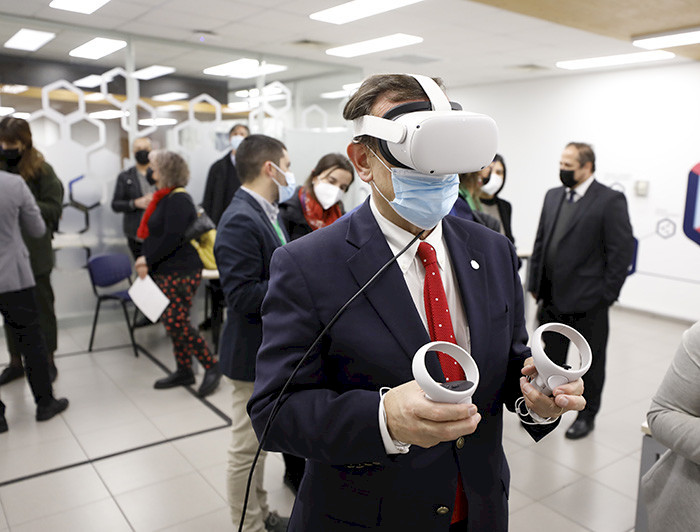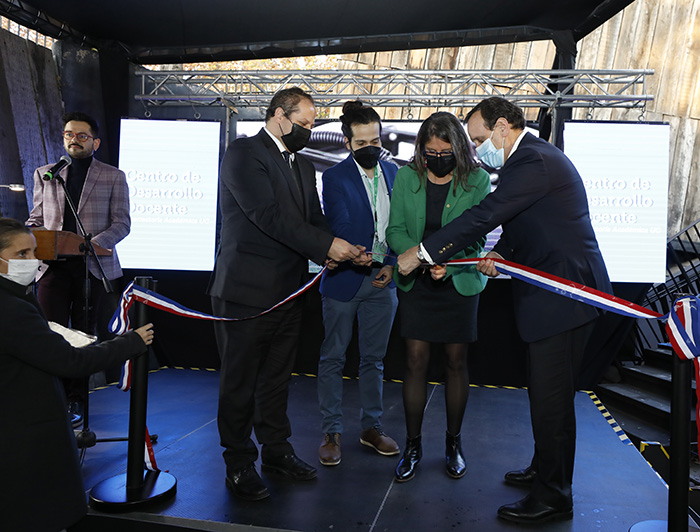UC Chile Fosters Innovation in Teaching Through a VirtuaLab
Located in the CDDoc building at the San Joaquín campus, this laboratory allows experimentation with immersive technologies—such as virtual and augmented reality—and 3D printing, applied to educational contexts. Together with the UC Chile MediaLabs, this lab is expected to contribute to the use of innovative technologies in teaching.

photo_camera The VirtuaLab was inaugurated at the beginning of June in an underground room of the Faculty Development Center (CDDoc) building on the San Joaquín campus (Photo: César Cortés)
Virtual reality headsets, 3D printers or digital prototyping tools are all devices that seem like they are out of an innovation and technology fair, but they are all part of the first UC Chile VirtuaLab.
This lab is a space specially designed for professors to create resources and learning experiences in virtual reality and 3D.
The VirtuaLab was inaugurated at the beginning of June in an underground room at the Faculty Development Center (CDDoc) building on the San Joaquín campus.
The ceremony was attended by President Ignacio Sánchez, Vice President for Academic Affairs Fernando Purcell, as well as faculty, students and officials.

The San Joaquín MediaLab and the MediaLab Móvil, audiovisual creation laboratories for the faculty, which have been in operation since last year, were also officially inaugurated.
The motivation to open these labs was also increased due to the pandemic. According to the Vice President for Academic Affairs, "The innovative capacity of our academic body, its drive and demands during the pandemic, were key for the CDDOc to design and implement this project."
For the CDDoc director, Chantal Jouannet, the pedagogical approach of these resources is key:
"Being able to create audiovisual content and incorporate immersive and 3D technologies enables us to continue educating the professionals that Chile needs today."
New Realities to Promote Learning
VirtuaLab is an active learning space that offers support to professors, so they can incorporate immersive reality technologies, prototyping and 3D printing into their classes.
There are two main types of immersive technologies: augmented reality (AR) and virtual reality (VR).
On the one hand, AR merges images of the physical world with a visual layer of digital elements (text, images, videos, animations or others). AR adds to reality through phones and tablets by projecting information on top of what you are already seeing.
On the other hand, VR creates a digital world that simulates reality through headsets. VR can also require the use of haptic gloves or suits (wearable devices) for an effective experience and interaction.
According to the CDDoc director, these technologies connect the real world with the virtual world, expanding pedagogical possibilities.
"We hope that new ways of teaching and learning will be explored and enhanced through these devices. That our students experiment with active methodologies, and that these technologies become a means for meaningful learning."

These immersive technologies are currently available to all UC Chile faculty.
To make use of them, assistance should be requested from the Faculty Development Center, which then provides expert personnel to support professors in the creation process.
To experiment and generate innovative pedagogical resources, the UC Chile has three MediaLabs, located in the Casa Central, San Joaquín and Villarrica campuses.
It also has a Mobile MediaLab to make audiovisual and interactive content (storyline), video tutorials, and animated resources.
All of them require the support of personnel from the Faculty Development Center.


